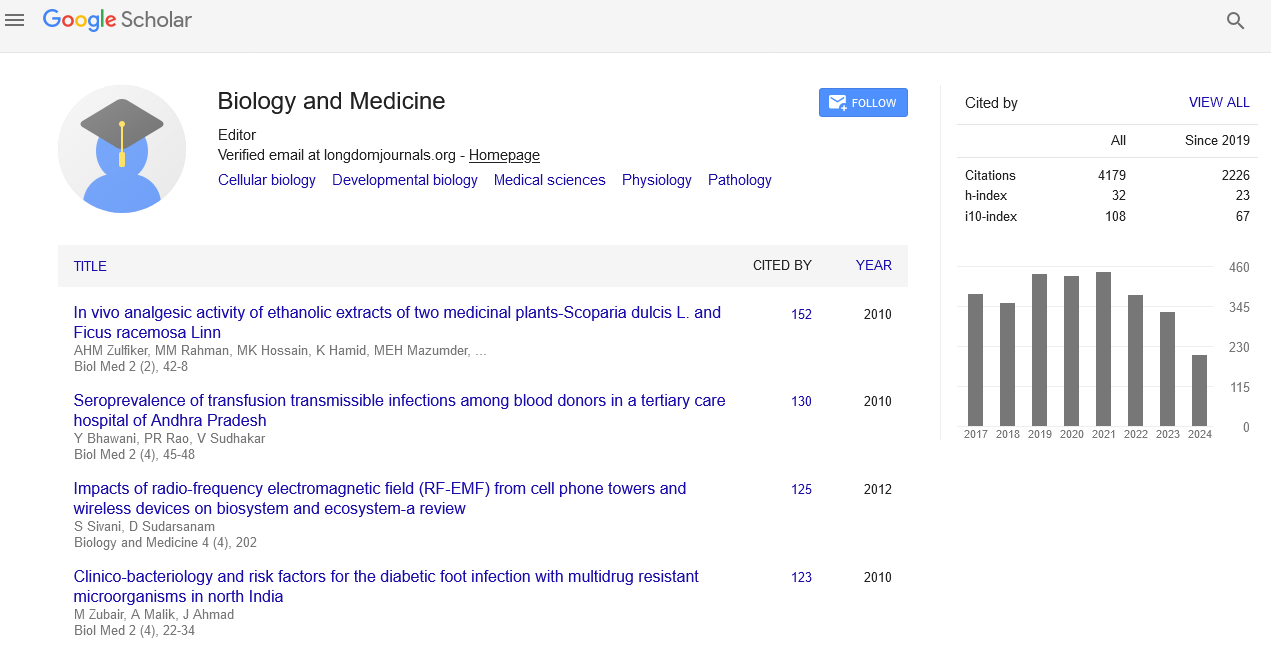Indexed In
- Open J Gate
- Genamics JournalSeek
- CiteFactor
- Cosmos IF
- Scimago
- Ulrich's Periodicals Directory
- Electronic Journals Library
- RefSeek
- Hamdard University
- EBSCO A-Z
- Directory of Abstract Indexing for Journals
- OCLC- WorldCat
- Proquest Summons
- Scholarsteer
- ROAD
- Virtual Library of Biology (vifabio)
- Publons
- Geneva Foundation for Medical Education and Research
- Google Scholar
Useful Links
Share This Page
Journal Flyer

Open Access Journals
- Agri and Aquaculture
- Biochemistry
- Bioinformatics & Systems Biology
- Business & Management
- Chemistry
- Clinical Sciences
- Engineering
- Food & Nutrition
- General Science
- Genetics & Molecular Biology
- Immunology & Microbiology
- Medical Sciences
- Neuroscience & Psychology
- Nursing & Health Care
- Pharmaceutical Sciences
Opinion Article - (2025) Volume 17, Issue 2
Bioluminescence in Medicine: Lighting Up Cancer and Bacteria
Haruto Nakashima*Received: 10-Feb-2025, Manuscript No. BLM-25-28803; Editor assigned: 14-Feb-2025, Pre QC No. BLM-25-28803 (PQ); Reviewed: 28-Feb-2025, QC No. BLM-25-28803; Revised: 07-Mar-2025, Manuscript No. BLM-25-28803 (R); Published: 14-Mar-2025, DOI: 10.35248/0974-8369.25.17.776
Description
Bioluminescence is a fascinating biological phenomenon in which certain organisms, such as fireflies, fungi, and some marine animals, produce light through biochemical reactions. This natural light is generated by the enzyme luciferase, which catalyzes the oxidation of luciferin, resulting in the emission of light. While bioluminescence is commonly observed in nature for purposes such as predator deterrence, mating displays, or prey attraction, its application in biomedical sciences is proving to be invaluable.
The ability to detect light from living organisms has led to the development of advanced bioluminescence-based techniques that are now widely used in cancer imaging, bacterial detection, and diagnostic research. These techniques allow for real-time visualization of disease processes at the molecular level, offering major advantages over traditional methods like radiography or fluorescence imaging. This article provides an overview of the role of bioluminescence in medical applications, highlighting its use in cancer research, infection diagnostics, and the growing field of biomedical imaging.
Cancer remains one of the most challenging diseases to treat, with early detection being crucial for successful treatment outcomes. Bioluminescence Imaging (BLI) is increasingly being used to monitor the growth and spread of cancerous tumors in real-time. By introducing a bioluminescent marker such as a luciferase gene into cancer cells, researchers can non-invasively track the progression of the disease in animal models and even in human patients during clinical trials.
In animal models, bioluminescence allows for highly sensitive and specific imaging of tumors. The luciferase gene is introduced into the tumor cells, and when luciferin is injected into the animal, it generates light that can be detected by specialized optical imaging devices. This technique provides real-time, quantitative data on tumor size, location, and metastasis. It is especially useful for studying tumor growth dynamics, evaluating the effectiveness of anti-cancer therapies, and monitoring relapse.
BLI offers several advantages over other imaging techniques, including high sensitivity, real-time monitoring, and the ability to capture changes at a molecular level. In particular, bioluminescence-based tumor imaging is non-invasive, minimizing the need for tissue biopsies or surgical interventions. This ability to monitor tumors in live animals, without the need for external markers, makes BLI an essential tool in preclinical cancer research.
Bioluminescence also has potential applications in cancer therapy. One innovative approach involves bioluminescence-guided surgery. Surgeons can use real-time bioluminescence imaging to identify tumor tissues and ensure complete removal, thus improving surgical outcomes. Additionally, bioluminescence-based assays can be used to screen for novel anticancer drugs, allowing researchers to assess the efficacy of treatments in real-time.
Researchers are also investigating bioluminescence as a therapeutic modality, using luciferase-based systems to trigger light-activated therapies. For example, optogenetic approaches in cancer therapy involve using light to activate certain proteins or signaling pathways within cancer cells, triggering specific therapeutic responses, such as cell death or tumor inhibition.
Infectious diseases, particularly those caused by bacterial pathogens, represent a major global health challenge. Traditional methods of bacterial detection, such as culturing and microscopy, can be time-consuming and may lack the sensitivity needed for rapid diagnosis. Bioluminescence offers a faster, more efficient way to detect and identify bacterial infections.
While bioluminescence is excellent for surface-level imaging, its ability to penetrate deep tissues is limited. This means that imaging is often restricted to superficial tumors or shallow biological processes. Advances in optical imaging technologies and bioluminescent probes may help overcome these limitations in the future.
As bioluminescence is used in an increasing number of clinical and research applications, there is a need for standardized protocols and reproducible methods to ensure that results are consistent across different laboratories and settings. The development of standardized bioluminescent markers and imaging systems will be crucial to the widespread adoption of this technology.
While bioluminescent imaging has many benefits, the ethical implications of using Genetically Modified Organisms (GMOs) for imaging, particularly in clinical settings, must be carefully considered. Ensuring that bioluminescent probes do not introduce new risks or complications will be essential for their safe application in human medicine.
Conclusion
Bioluminescence is a revolutionary tool in the field of medicine, offering unique advantages for real-time diagnostics, cancer imaging, bacterial detection, and biomedical research. As technology improves, bioluminescence will likely become an integral part of personalized medicine, enabling more precise and non-invasive monitoring of disease progression and treatment efficacy. While challenges remain, the potential for bioluminescence to illuminate the path toward better healthcare is vast, with exciting applications on the horizon.
Citation: Nakashima H (2025). Bioluminescence in Medicine: Lighting Up Cancer and Bacteria. Bio Med. 17:776
Copyright: © 2025 Nakashima H. This is an open-access article distributed under the terms of the Creative Commons Attribution License, which permits unrestricted use, distribution and reproduction in any medium, provided the original author and source are credited.


